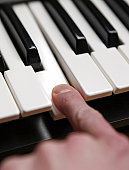
Home > Ear Training > Hearing Chord Movements
|
||||
Hearing Chord Movements on Piano
How can this be done? It can only be achieved by training your ear to identify certain sounds. Like how you would train a dog to do a trick on command. The first, and easiest step to achieve this, is to listen for the bass of the progression. All chord progressions have a bass, a melody, or overtones, and the harmony in the middle. The bass usually plays the root notes of the chords, so it is mostly easy to hear where the progression goes. Lets start with a quick exercise: Play a C on your piano. Then play F above it. Then C again, and then the G below. Sing along with it. You will start to get use to the sounds and jumps of the different intervals. Now play a simple chord progression on your piano, and listen especially to the bass. Can you hear it? Now, play it again, and sing with the bass. Now try other progressions, and you will immediately start to feel confident about recognizing the various bass movements on your piano. As you moved along in the previous exercise, the one thing you probably recognized, was the highest notes of the progression. You could easily memorize it, especially if the progression is short enough. The secret is, that you would only need these two, the bass, and the melody, or the high notes to figure out chord movements. These form the structure, or the skeleton of the whole progression. Now only play the bass and the melody of different types of progressions, until you feel comfortable with it. Now, put the flesh of the chords back in, and see if you can still hear the outer lines of the progression “bass and high notes”. The next part to train your ear, is to take a certain progression! lets say, I to IV, to V, and practise that over and over, until your ears want to burst.
Your mind will start to distinguish them. Now take more complicated movements, like: I, IV, V, VI. The sixth of the scale, which is a minor in a major scale, brings a surprise to the ear, because it is a minor. A lot of songs use minor chords in different places, and it acts as landmarks to our ears. When you travel by car, you look out for certain landmarks, don’t you? Just like our ears. Try to listen to a song, and where it changes to another key, or use a strange chord, you’ll know it and pick it up instantly. It’s the similarities or common notes that the chords hold to one another that form these landmarks. I.E. C Major: C E.G., a minor, A C E. Play the arpeggios of the different chords to give you the feel of common notes between chords. Here are a few extra tips to help you more. You could try to “zoom in” to the movement of a specific note or line in a progression. Chords sound differently. Major sounds different from minor, and diminished from augmented. Play arpeggios with these chords to make your ears used to the sound of them. Lastly, improvising also helps you training your ears hearing chord movement. Have fun experimenting.
Check out Perfect Pitch Supercourse for the proven method of learning perfect pitch...
| ||||
|
Although every attempt has been made to make information as accurate as possible, we are not responsible for any errors that may appear.
 If there is one thing that is difficult for a beginner pianist, or even some
advanced musicians, it is the ability to hear chord changes on a piano, in music, in a song, etcetera. Most
people just listen to enjoy the song. But for musicians, it is very important to learn to hear or listen for
the different chord movements or chord progressions.
If there is one thing that is difficult for a beginner pianist, or even some
advanced musicians, it is the ability to hear chord changes on a piano, in music, in a song, etcetera. Most
people just listen to enjoy the song. But for musicians, it is very important to learn to hear or listen for
the different chord movements or chord progressions.
 Listen to chord movements of songs played on the radio, and see if you can
hear that specific chord progression being played.
Listen to chord movements of songs played on the radio, and see if you can
hear that specific chord progression being played.



